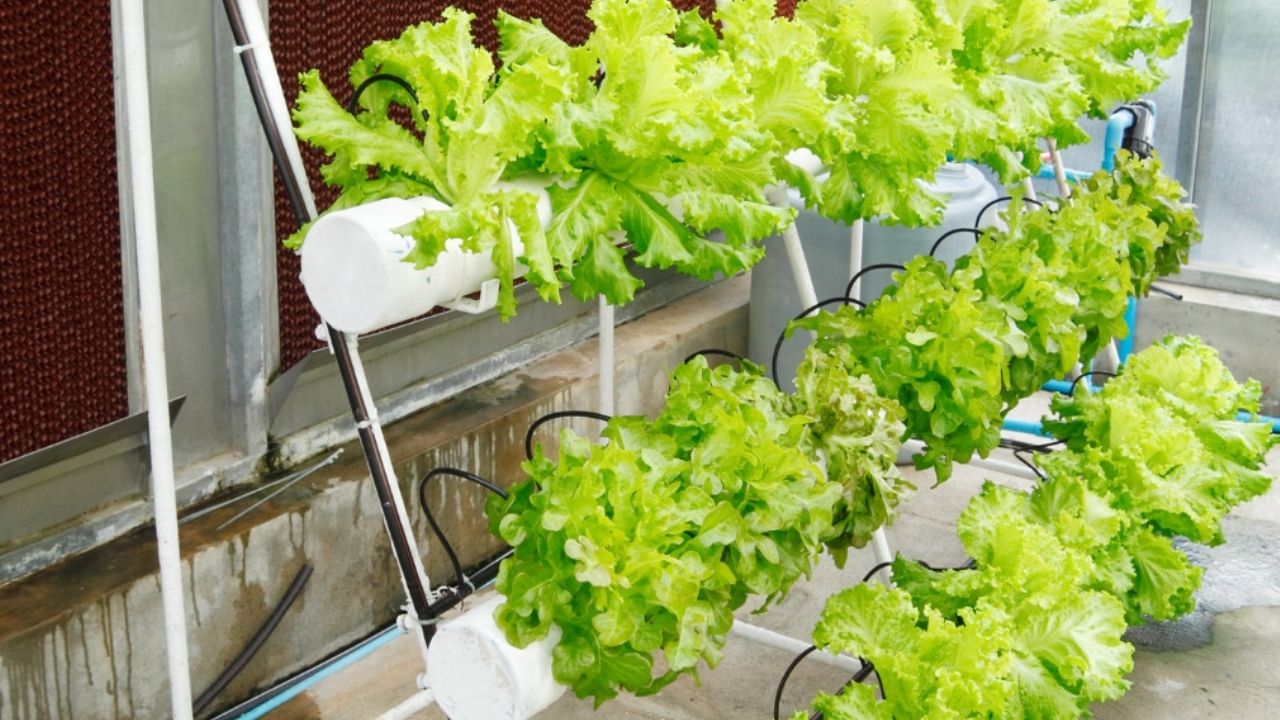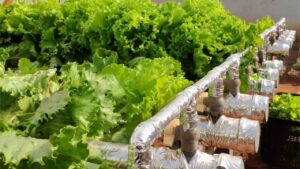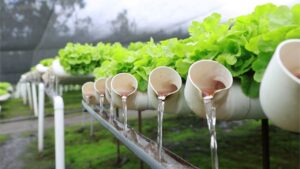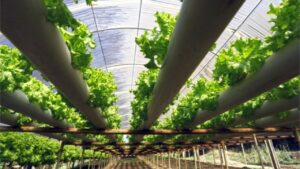Hydroponics is a method of growing plants without soil, where the roots are directly supplied with a nutrient-rich solution essential for their growth. This technique has gained popularity in recent years, especially in urban areas where space for traditional gardening is limited.
With increasing urbanization, finding sustainable ways to produce food in small spaces has become a priority. Hydroponics not only optimizes space usage but also uses less water than conventional methods and eliminates the need for chemical pesticides, making it an eco-friendly and efficient alternative.
In this article, we will explore how hydroponics can be a practical and sustainable solution for those who want to grow fresh food in small environments, such as balconies, walls, or even inside apartments. Additionally, we will highlight the benefits of this method and provide tips to set up your own hydroponic garden, transforming any urban space into a small green oasis.
What is Hydroponics and How Does It Work?
Hydroponics is a plant-growing system that eliminates the use of soil, replacing it with a nutrient-rich solution essential for plant development. In this method, the roots are suspended in water or supported by inert substrates such as expanded clay or rock wool, while directly receiving the nutrients needed for healthy growth.
Unlike traditional gardening, where plants rely on soil to extract nutrients, hydroponics offers greater control over the growing environment. With this method, it is possible to precisely adjust the amount of nutrients, water, and light the plants receive, resulting in faster and more efficient growth. Additionally, the absence of soil reduces the risk of pests and diseases, eliminating the need for pesticides.
The advantages of hydroponics in limited spaces are particularly noteworthy. Hydroponic systems can be set up vertically, utilizing walls or hanging structures to maximize space usage. This setup is ideal for those living in apartments, houses without backyards, or densely populated urban areas. Furthermore, the water savings and nutrient efficiency make hydroponics a sustainable choice for growing fresh and healthy food in small spaces.
Sustainability and Hydroponic Gardens
Hydroponics stands out as a sustainable alternative to traditional farming methods, offering numerous environmental benefits and promoting a more conscious use of natural resources.
One of the key sustainable features of hydroponics is the significant reduction in water consumption. While conventional gardening can waste large amounts of water due to evaporation and soil drainage, hydroponic systems reuse water in a closed cycle. This process can save up to 90% of the water compared to traditional cultivation, making it an ideal technique for regions facing water scarcity.
Additionally, hydroponics enables cleaner cultivation by eliminating the need for chemical pesticides. Since plants grow in a controlled environment, the risk of pests and diseases is minimized, reducing the environmental impact caused by agricultural chemicals. This results in healthier, chemical-free food.
Another important aspect is the reduction of the carbon footprint associated with food production. In urban hydroponic systems, it is possible to grow food locally, decreasing reliance on long transportation routes and the use of fossil fuels. This proximity between cultivation and consumption also encourages seasonal production and ensures fresher food, enhancing both environmental and health benefits.
With these factors, hydroponic gardens represent an innovative and sustainable solution that combines resource efficiency with environmental preservation while meeting the growing demand for healthy food in cities.
Benefits of Hydroponics in Small Spaces
Hydroponics is a versatile and efficient solution for those looking to grow plants in limited spaces, especially in urban areas where land is scarce. With its adaptability and innovative techniques, this cultivation method offers numerous advantages for small environments.
One of the major attractions of hydroponics is its adaptability to balconies, walls, and small backyards. Unlike traditional methods, hydroponic systems can be tailored to fit any available space, regardless of its shape or size. From compact containers to hanging systems, it is possible to create a productive garden even in apartments or homes without yards.
Vertical farming is another significant advantage, allowing for space optimization. Vertical systems use structures like shelves, pipes, or panels to grow multiple plants in layers. This approach not only increases planting capacity but also enhances accessibility and organization, making the garden both visually appealing and functional.
Moreover, hydroponic gardens in small spaces help create a green and healthy environment in urban areas. The presence of plants improves air quality, reduces noise, and promotes a more relaxing atmosphere. Having a garden at home also encourages healthier eating habits, providing easy access to fresh, pesticide-free food.
With these benefits, hydroponics not only transforms limited spaces into productive areas but also offers a sustainable and accessible way to integrate food cultivation into daily life, even in the densest cities.
Types of Hydroponic Systems for Small Spaces
When adopting hydroponics in small spaces, choosing the right system can make all the difference in the success of your garden. Each system has characteristics that suit different needs and types of environments. Here are some of the most popular hydroponic systems for making the most of small spaces.
1. Nutrient Film Technique (NFT)The Nutrient Film Technique (NFT) is one of the most efficient and common methods for urban hydroponic gardens. In this system, the nutrient solution continuously flows in a thin layer over the plant roots, ensuring they receive nutrients consistently. Ideal for small spaces, NFT can be set up compactly and vertically, using inclined tubes where plants grow. This system is excellent for leafy greens and herbs, such as lettuce and basil.
2. Drip SystemThe Drip System is another popular choice for hydroponic gardening in limited areas. In this system, the nutrient solution is delivered directly to the plant roots through small drippers, allowing for precise control over the amount of water and nutrients. This system is suitable for a variety of plants, including tomatoes and peppers. Additionally, it can be easily adjusted to fit small spaces and is resource-efficient.
3. Modular Vertical SystemsModular vertical systems are ideal for those looking to maximize available space in small areas. As the name suggests, these systems consist of stacked modules, allowing for cultivation in multiple layers. This fully utilizes the available area and can be installed on walls, fences, or suspended structures. The modular design allows for expansion as needed and can be adapted to different types of plants, from vegetables to herbs.
4. Cost-Benefit Analysis for Small SpacesWhen choosing a hydroponic system, it’s essential to consider the initial cost and maintenance of the system in relation to the benefits it offers. Systems like NFT and drip tend to be more affordable and require less space, but may need more adjustments and monitoring. Modular vertical systems might have a higher initial cost due to the necessary structure, but they offer excellent space utilization and can be easier to expand. In all cases, the benefits include efficient resource use, lower maintenance needs, and the ability to grow fresh food at home, making the long-term investment worthwhile.
When selecting the right system for your hydroponic garden, it’s important to evaluate your specific needs, available space, and the types of plants you wish to grow. With the right choice, hydroponics can turn even the smallest urban spaces into productive little gardens.
6. How to Set Up Your Sustainable Hydroponic Garden
Setting up a sustainable hydroponic garden at home may seem challenging at first, but with the right materials and approach, the process is simple and rewarding. Below, we’ll outline the necessary materials, a step-by-step guide to get started, and tips for ensuring your garden remains as sustainable as possible.
Necessary Materials
- Support StructureThe structure is essential for supporting the hydroponic system. Depending on the type of system chosen, you may need shelves, pipes, or vertical panels. Sustainable and affordable options include recycled wood, PVC pipes, or other reusable materials.
- Nutrient ReservoirThe reservoir is where the nutrient solution will be stored. It can be made from durable plastic, wood, or other materials that don’t contaminate the water. The size of the reservoir will depend on the size of your system and the number of plants you wish to grow.
- Nutrient SolutionThe nutrient solution is the “food” for your plants. It contains essential minerals like nitrogen, phosphorus, potassium, and others. You can either buy pre-made solutions or make your own using organic fertilizers and homemade solutions for a more eco-friendly approach.
- Substrate or Growing MediumAlthough hydroponics eliminates the use of soil, plants still need a medium to support their roots. Common substrates include rock wool, expanded clay, perlite, or vermiculite. The choice of substrate will depend on the system type and the plants you plan to grow.
- Irrigation SystemIf you opt for a drip system or other methods that require controlled irrigation, you’ll need tubes, drippers, or water pumps. The irrigation system should be efficient and easy to maintain to ensure the nutrient solution reaches the roots adequately.
Step-by-Step Guide to Get Started
- Choose the Ideal LocationSelect a location with good natural light or the ability to provide artificial light. Make sure the environment is well-ventilated to avoid excess moisture buildup.
- Set Up the StructureOnce you have your materials, start assembling the support structure for the plants. If you’re using a vertical system, attach the modules or shelves to a wall or a sturdy structure. Ensure the setup is stable and secure.
- Prepare the Reservoir and Nutrient SolutionInstall the nutrient reservoir and prepare the nutrient solution according to the needs of the plants you want to grow. Regularly check the pH levels and nutrients to ensure the plants are receiving the proper support.
- Install the Irrigation SystemConnect the tubes, drippers, or other irrigation components to your growing system. Test the flow of the nutrient solution to ensure the irrigation is adequate and efficient.
- Plant Seeds or SeedlingsPlace the seeds or seedlings in the substrates, following the recommended depth and spacing guidelines. Make sure the roots are positioned well to absorb nutrients and water efficiently.
- Monitor and AdjustAfter setting up the garden, monitor the plant growth, the health of the irrigation system, and the nutrient levels. Adjust the nutrient solution, pH, and light as needed.
Tips for Maintaining Sustainability in Your Garden
- Use Recycled Materials: Whenever possible, use recycled or reusable materials to build the structure and irrigation system. This reduces environmental impact and contributes to a more eco-friendly garden.
- Recycle Water: To maintain sustainability, recycle the water used in the system. Some hydroponic systems already feature a recirculation mechanism, which helps minimize waste.
- Use Organic Fertilizers: Instead of using synthetic fertilizers, opt for organic nutrient solutions or compost to nourish your plants naturally and sustainably.
- Grow Seasonally: Grow plants that adapt well to the seasons and avoid excessive use of artificial light, which can increase energy consumption.
- Monitor Energy Efficiency: If you use artificial lighting, choose LED lamps, which consume less energy and have a longer lifespan.
Setting up a sustainable hydroponic garden at home is an effective way to produce fresh, healthy food while contributing to environmental preservation. By following these steps and tips, you’ll be on the right track to creating a thriving and sustainable green space in your home.
Examples of Ideal Plants for Small Spaces
When it comes to choosing the right plants for your hydroponic garden in small spaces, it’s important to consider the type of plant, growth time, and how well it adapts to the limited environment. Here are some great options for anyone looking to start a hydroponic garden in a compact space.
1. Aromatic Herbs
Aromatic herbs are an excellent choice for hydroponic gardens in small spaces because they don’t require much room to grow and can be cultivated in small containers or vertical systems. Some of the most popular options include:
- Basil: A versatile herb that can be used in a variety of dishes, from salads to pasta. Basil grows quickly and adapts well to hydroponic systems.
- Mint: Ideal for vertical systems or small containers. Mint is easy to grow and offers a fresh, fragrant aroma for various preparations.
- Parsley: Parsley is another herb that grows well in small spaces. Besides being flavorful, it’s rich in nutrients and can be used in many recipes.
These herbs can be grown near the kitchen, making it easy to use them fresh and daily, and are perfect for those with limited space.
2. Fast-Growing Leafy Greens
Fast-growing leafy greens are an excellent option for those who want quick results from their hydroponic garden. Many of these plants can be harvested just a few weeks after planting, making them ideal for small spaces or for those who want a continuous harvest. Some options include:
- Lettuce: Lettuce is one of the easiest and fastest vegetables to grow hydroponically. It grows well in NFT or drip systems and can be harvested in just 30 to 40 days.
- Arugula: Arugula is another fast-growing option that adapts well to hydroponic systems. It can be harvested in 30 to 45 days and makes a great addition to salads.
- Spinach: Spinach grows well in hydroponics and can be harvested in about 40 days. It’s rich in nutrients and can be eaten fresh or cooked in various dishes.
These leafy greens are perfect for those who want to grow fresh and nutritious food quickly without taking up much space.
3. Small Vegetables
For those who want to grow small vegetables in their hydroponic garden, there are several options that adapt well to limited spaces and still produce excellent results. Some suggestions include:
- Bell Peppers: Bell peppers, especially small varieties like mini peppers or chili peppers, can be successfully grown in hydroponic systems. They adapt well to small spaces and provide abundant harvests.
- Cherry Tomatoes: Cherry tomatoes are ideal for small spaces as they grow on compact plants that can be cultivated on shelves or vertical supports. They produce sweet and delicious fruits in no time, making them a great option for those with limited space but looking for fresh tomatoes.
These vegetables can be easily grown in vertical or modular hydroponic systems, maximizing the use of available space.
When selecting plants for your hydroponic garden in small spaces, consider their growth time, light needs, and the amount of space available. Aromatic herbs, fast-growing leafy greens, and small vegetables are great options that adapt well to urban environments and ensure fresh, healthy harvests. With hydroponics, even the most limited spaces can be transformed into productive little gardens, offering fresh and flavorful food right at your doorstep.
- See Also: Passo a Passo para Criar um Sistema de Compostagem em Pequenos Espaços
- Follow Us: https://www.facebook.com/profile.php?id=61565415975218
Success Stories: Real Inspirations
Hydroponic gardens are gaining popularity in urban settings, transforming small spaces into true oases of fresh, sustainable food. Below, we share some inspiring stories of successful hydroponic projects in limited spaces, demonstrating how creativity and intelligent use of space can lead to impressive results.
1. Hydroponic Garden on an Apartment Balcony
In a bustling city, Maria, a resident of an apartment in downtown São Paulo, decided to turn her small 8m² balcony into a hydroponic garden. She installed an NFT (Nutrient Film Technique) system using recycled PVC pipes and a water reservoir that efficiently recirculates water. Maria began by growing aromatic herbs like basil and mint, and soon expanded to lettuce, arugula, and cherry tomatoes.
The garden on her balcony not only provided fresh food for Maria’s kitchen but also became a relaxation spot and a way to practice sustainability in her daily life. With the hydroponic system, she was able to optimize the use of space without taking up the limited indoor area of her apartment, which lacks outdoor space.
2. Hydroponic Project on a Building Roof
In an urban neighborhood with limited space, a group of residents from Rio de Janeiro decided to use the roof of a building to create a community hydroponic system. The project aimed to grow fresh food locally and reduce the environmental impact of long-distance food transport.
The roof was divided into modules, with vertical structures built to grow a wide variety of plants, such as lettuce, spinach, tomatoes, and aromatic herbs. The use of LED lights and an automated irrigation system helped maximize the cultivation efficiency. The project was a success, providing fresh food to the community and fostering a sense of unity among the residents.
3. Hydroponic Garden in a 30m² House
In a small house in the interior of São Paulo, João and his wife Ana decided to use the limited space available to create a hydroponic garden for their family’s consumption. With a house of only 30m² and no room for traditional gardening, they chose a drip system to grow fast-growing vegetables such as lettuce, arugula, and carrots.
In addition to providing a practical and sustainable way to obtain fresh food, the garden helped reduce the need for supermarket purchases, providing healthier, pesticide-free food. João and Ana also share the benefits of hydroponics with their neighbors, inspiring others to adopt the practice in their own homes.
4. Vertical Hydroponic System in a 40m² Apartment
Lucas, a young professional living in a 40m² apartment in downtown Belo Horizonte, decided to set up a vertical hydroponic garden to grow his own vegetables. He used modular structures made from recycled wood and installed vertical shelves on the wall to maximize the use of space.
His system uses a water reservoir that is easily accessible and controlled, and Lucas grows cherry tomatoes, peppers, lettuce, and herbs like basil and thyme. In addition to providing fresh food for his meals, the project turned the apartment wall into a green garden, creating a more pleasant and healthy environment.
These success stories show that it’s possible to grow fresh, healthy food in practically any environment, from small apartments to urban rooftops. Hydroponics offers a practical and efficient solution for anyone wanting to have a garden in limited spaces, without sacrificing sustainability and productivity. These real-life projects serve as inspiration for those looking to start their own hydroponic journey and transform their urban space into a garden of fresh, sustainable food.
Conclusion
As we’ve explored throughout this article, hydroponic gardening offers an incredible solution for growing fresh, healthy food in small urban spaces. By eliminating the need for soil and optimizing the use of limited space, hydroponics allows you to create a productive garden in environments where traditional gardening might not be possible. Whether on a balcony, rooftop, or even indoors, hydroponic systems provide an efficient and sustainable way to cultivate plants without the constraints of traditional gardening methods.
Recap of the Benefits of Hydroponic Gardens for Small Spaces
Hydroponics offers numerous benefits for those with limited space. Some of the key advantages include:
- Maximized Space Efficiency: Vertical gardening and compact systems make it possible to grow a variety of plants in small areas.
- Water Conservation: Hydroponic systems use up to 90% less water compared to traditional soil-based gardening.
- Pesticide-Free: With no soil, there’s a reduced risk of pests, allowing for chemical-free, healthier produce.
- Quick Harvests: Many hydroponically grown plants mature faster, ensuring a continuous supply of fresh food.
Call to Action: Get Inspired and Start Your Own Garden
Now that you’ve learned about the many benefits of hydroponics, it’s time to take action! Don’t wait for the perfect space or perfect time—begin your hydroponic journey today. Start with a simple system, perhaps with herbs or leafy greens, and gradually experiment with different plants as you become more confident. The possibilities are endless, and the rewards of fresh, homegrown food are worth the effort.
A Reflection on the Positive Impact of Urban Sustainability
Hydroponic gardening isn’t just about growing food—it’s also about fostering a more sustainable, eco-friendly urban environment. By growing your own food, you reduce your reliance on commercial agriculture, decrease your carbon footprint, and contribute to the growing movement of sustainability in cities. As more individuals embrace hydroponics in small spaces, we move closer to creating self-sufficient urban communities where fresh food is always within reach.
So why not take the first step today and begin transforming your small space into a green, sustainable oasis?




